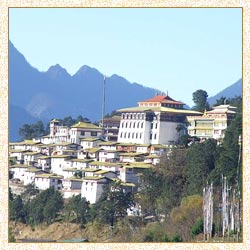Buddhist Monastery
The term Monastery has been derived
from a Greek word 'monasterion', which means the habitat and workplace
of a community of monks or nuns. In Buddhism, a monastery is known as
Vihara or Gompa. The exact time of the emergence of Buddhist monasteries
is not known. It is believed that they emerged somewhere around the
fourth century BC. The practice of vassa, the retreat undertaken by
Buddhist monks and nuns during the South Asian rainy season, is said to
have been the inspiration behind the Buddhist monastery.
Under Vassa, wandering Buddhist monks and nuns were confined in a particular place for the monsoon season, lasting for approximately three months. This was done to prevent them from upsetting new plant growth or becoming stranded in stormy weather. These retreats were organized in the pavilions and parks donated to the sangha, by wealthy supporters. With the passage of time, this routine of staying in the retreats during the vassa retreat advanced into an austere lifestyle for the nuns and the monks.
They started living in the monasteries as a Sangha, throughout the year. Initially, Buddhist monasteries were used as residence by the Sangha, as a whole. However, later this practice changed in some of the counties and only the monks started residing in the monasteries. For the nuns, nunneries started coming up. In the Indian subcontinent, Buddhist monasteries progressively grew into centers of learning. They served as the places where philosophical principles were developed and debated. In some of the countries, monasteries also became large landowners.
Peasant families worked on the land of the monastery and in exchange, gave the monks a portion of their yearly crop. While in others, the monastery came under the ownership of a single monk, who passed it on from generation to generation. In the Theravada traditions of Southeast Asia and Sri Lanka, one can also find forest monasteries. Theses monasteries do not perform scholarship or ceremonial duties. Rather, they are devoted to the study of Buddhist meditation.
Under Vassa, wandering Buddhist monks and nuns were confined in a particular place for the monsoon season, lasting for approximately three months. This was done to prevent them from upsetting new plant growth or becoming stranded in stormy weather. These retreats were organized in the pavilions and parks donated to the sangha, by wealthy supporters. With the passage of time, this routine of staying in the retreats during the vassa retreat advanced into an austere lifestyle for the nuns and the monks.
They started living in the monasteries as a Sangha, throughout the year. Initially, Buddhist monasteries were used as residence by the Sangha, as a whole. However, later this practice changed in some of the counties and only the monks started residing in the monasteries. For the nuns, nunneries started coming up. In the Indian subcontinent, Buddhist monasteries progressively grew into centers of learning. They served as the places where philosophical principles were developed and debated. In some of the countries, monasteries also became large landowners.
Peasant families worked on the land of the monastery and in exchange, gave the monks a portion of their yearly crop. While in others, the monastery came under the ownership of a single monk, who passed it on from generation to generation. In the Theravada traditions of Southeast Asia and Sri Lanka, one can also find forest monasteries. Theses monasteries do not perform scholarship or ceremonial duties. Rather, they are devoted to the study of Buddhist meditation.
uddhist Monasteries in Arunachal
 Located
in the Northeastern part of India, Arunachal Pradesh is one of the most
beautiful and picturesque locations in India. The state of Arunachal
Pradesh offers a variety of flora and fauna that is sure to lure any
tourist. For centuries, Arunachal has been the land of Buddhists and
known for some of the largest Buddhist monasteries in India. Some of the
important Buddhist monasteries in Arunachal Pradesh include the Bomdila
monastery and the Tawang monastery.
Located
in the Northeastern part of India, Arunachal Pradesh is one of the most
beautiful and picturesque locations in India. The state of Arunachal
Pradesh offers a variety of flora and fauna that is sure to lure any
tourist. For centuries, Arunachal has been the land of Buddhists and
known for some of the largest Buddhist monasteries in India. Some of the
important Buddhist monasteries in Arunachal Pradesh include the Bomdila
monastery and the Tawang monastery.Bomdila Monastery
Bomdila Monastery, situated in state of Arunachal Pradesh, dates back to the year 1965. It owes its inception to the 12th reincarnate of Tsona Gontse Rinpoche, who got this monastery built before his death in the year 1966. The monastery of Bomdila is an imitation of the Tsona Gontse Monastery, located at Tsona in South Tibet. The main prayer hall of the monastery was added later on by the 13th reincarnate of Tsona Gontse Rinpoche. This hall was later sanctified by His Holiness, the 14th Dalai Lama, in October 1997.
Tawang Monastery
Tawang Monastery is situated in the state of Arunachal Pradesh. It lies at a distance of approximately 180 km from Bomdilla. The monastery stands hovering on a hilltop, at an altitude of approximately 10,000 ft. One of the largest Buddhist monasteries in India, Tawang Gompa also holds the distinction of being the birthplace of the 6th Dalai Lama. Known by the name of Galden Namgyal Lhatse also, the monastery dates back to the year 1860-61.

No comments:
Post a Comment
We highly admire your helpful comments on our posts.